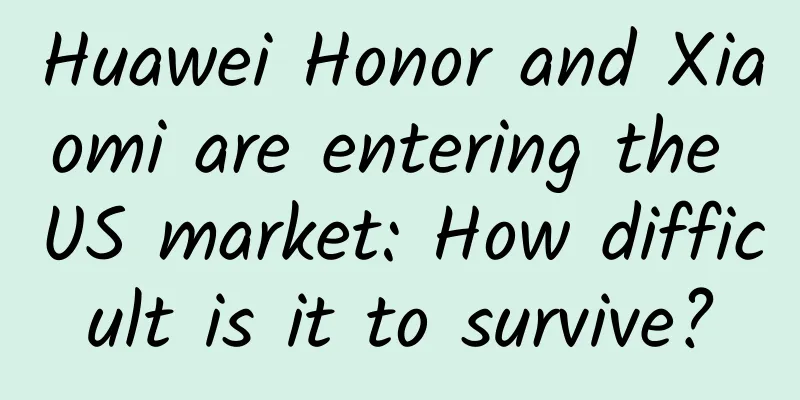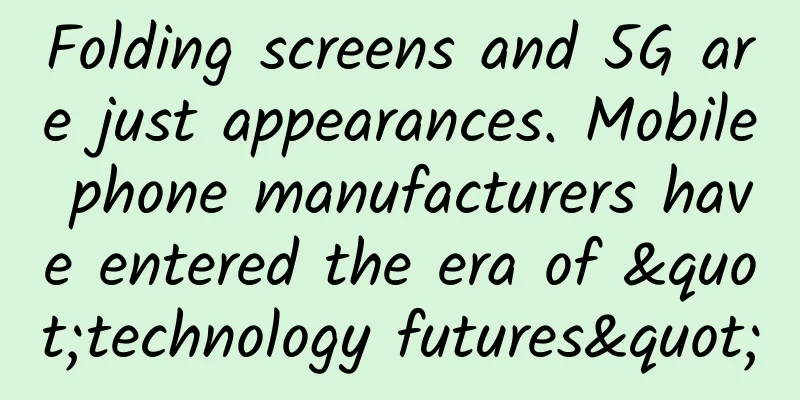Huawei Honor and Xiaomi are entering the US market: How difficult is it to survive?

|
Recently, as domestic mobile phone shipments have become increasingly saturated, Xiaomi and Huawei Honor have both set their sights on the US smartphone market. Xiaomi Vice President Hugo Barra revealed that Xiaomi will soon enter the US mobile phone market and sell through young fan communities and online channels. In addition, Huawei officially launched the US version of its sub-brand Honor 8 at the San Francisco Museum of Natural History, becoming Honor's second product to enter the US market. Why are Xiaomi and Honor entering the US market? Xiaomi and Honor have entered the US market. The reason is obviously related to the gradual saturation of the domestic smartphone market. The pressure of growth in the domestic market is increasing, especially for Xiaomi. This year, Xiaomi mobile phones have gradually shown a downward trend. In the second quarter of this year, Xiaomi's shipments accounted for 10.4% of the domestic market share, while Huawei ranked first with a market share of 14%, followed by OPPO (12.7%) and vivo (11.2%). According to IDC data, Xiaomi's mobile phone shipments in the second quarter fell 38% year-on-year. Xiaomi's market share was eroded by rivals such as Huawei and OPPO, and its desire to expand overseas is more urgent than anyone else. Secondly, it is necessary to adopt a high-end strategy. As the brand recognition in the domestic market gradually increases, if we want to enter the high-end market and further increase the brand premium, we obviously cannot be limited to the domestic market. We must gain brand recognition in the United States, the global technology and economic center, in order to be recognized internationally. Once again, the US market environment has ushered in a favorable situation. We know that due to the high subsidies provided by US operators, consumers only need to use the operator's package to buy iPhone and Samsung flagship phones at a low price with a two-year contract price, but this situation is about to change. Not long ago, the four major US operators ended the relevant contract products and eliminated the two-year contract system. The elimination of the contract system in the United States and the full-price purchase of mobile phones may also cause some changes in the smartphone market structure, which will also make it easier for domestic mobile phones to enter the US market and gain some price advantages. Huawei and Xiaomi are both prepared in terms of patents, but there are still risks Of course, as we all know, entering the US market requires breaking patent barriers. Xiaomi and Huawei Honor have also made some preparations. For example, in June, Xiaomi acquired nearly 1,500 technology patents from Microsoft. In Xiaomi's view, this transaction will reduce the intellectual property disputes it may encounter when expanding overseas markets. Huawei also believes that it is ready. According to data, Huawei has 9,800 patents in the United States, of which 7,400 are communication technology patents and 2,200 are digital processing technology patents. But at the same time, Xiaomi and Honor still need to make adequate preparations for the patent challenges in the US market. As mentioned earlier, Xiaomi's acquisition of some of Microsoft's patents can reduce patent disputes, but it does not mean that all obstacles have been eliminated. Xiaomi's patent foundation is relatively weak. Previously, due to patent issues, some Xiaomi models were banned from sale in India. All the underlying technologies of mobile phone products originated from Europe and the United States, including patents for application processors, camera modules, and basebands. In the United States, many patent trolls rely on patent litigation claims and authorizations to make profits. Xiaomi is currently unable to cover all the lawsuits on U.S. patent property rights and the weak links of its own patents, making it easy to become the prey of their patent litigation. Some industry insiders even pointed out that Xiaomi's future revenue in the United States may not be able to offset the patent litigation costs initiated by relevant U.S. manufacturers and patent trolls. ZTE and Huawei have both encountered patent lawsuits in the United States. However, Huawei has accumulated a certain amount of patents over the years and has a certain ability to deal with patent lawsuits, but there are still risks. Another major problem for Huawei is that the US market is now the biggest obstacle to the expansion of Huawei's mobile phone global market. In the eyes of Americans, Huawei has a military background and believes that Huawei's telecommunications network equipment will threaten their network security, so they let the Honor brand pave the way first. Huawei Honor does not need to be tested by operators to enter the United States. Huawei terminals in the United States are qualified for whole-machine testing. The inability to secure US operator channels has already determined the ceiling of development Another problem is the sales channel. In the United States, to sell mobile phones, you need to have a good relationship with operators. Unlike other regions in the world, about 95% of smartphone sales in the US market are sold through operator channels. If you can't get the operators, you will basically see the ceiling for selling mobile phones in the US market. Because of the important position of operators in terminal sales in the United States, a mobile phone launched in the United States needs to pass the U.S. National Access Certification (FCC) and third-party certification, as well as the operator's on-line testing. In addition, American consumers have a long replacement cycle, so there are very strict requirements for brand, quality, after-sales, components, production lines and even environmental protection, and the threshold is relatively high. In addition, in order to ensure quality and brand as well as cooperation needs, operators will not purchase machines at too low a price, which is extremely disadvantageous for domestic manufacturers who have always focused on cost-effectiveness. Market channels and user positioning are misaligned: China's social network marketing culture is also difficult to gain popularity in the United States The route chosen by Huawei Honor in the United States is to avoid operators and go online. Honor cooperates with e-commerce channels such as Amazon to sell in the United States. Huawei Honor has established an official Honor website in the United States and stated that users can communicate with Honor fans around the world on the forum and can also purchase on the official website. Since Xiaomi is entering the US market for the first time, it has chosen to go online and use social networks for marketing, given the barriers to entry into US operator channels. Xiaomi also said that it has established connections with young people in the US who are very enthusiastic about new technologies through online retail channels and social network marketing. In addition, we can know that from the perspective of market, users and channels, the entry of Honor Xiaomi brand into the US market does not actually fit the situation of mainstream users in the US market. First of all, the US mobile phone market is mainly in the mid-to-high-end market, but Xiaomi Honor is positioned in the mid-to-low-end market. The US market is dominated by operators. Operators account for 95% of smartphone sales in the United States, which are mainly offline, while Xiaomi Honor is mainly online. Even online, US users are more accustomed to buying mobile phones from the operator's online store, because they can be sure that the mobile phone is compatible with the operator's network without having to deal with various troubles such as whether the SIM card matches. Therefore, if Xiaomi and Huawei only sell mobile phones through their own online platforms, this is contrary to consumer habits. Therefore, to some extent, Xiaomi and Honor's entry into the US market is misplaced in terms of market channels and user positioning. Xiaomi, Huawei and Honor's choice of online sales model and social network marketing in the US market is also putting the cart before the horse, making it difficult to achieve large-scale development. The price-performance ratio is not applicable. American consumers’ pursuit of mobile phones is different from that of Chinese consumers. On the other hand, according to the survey results of data research company comScore, Apple and Samsung are still the two giants in the US market. Apple iPhone's market share in the US is as high as 43.5% and is still rising, while Samsung's market share remains stable at 28%, and together they account for nearly 70% of the market share. Judging from the current positioning of Xiaomi and Honor, it is obvious that they are not going to compete for the high-end market, but to compete for the market share of the mid-to-low-end market, which can obviously only rely on cost-effectiveness. In China, domestic mobile phones benefit from high import tariffs, which increase the price of foreign mobile phones, making domestic mobile phones more cost-effective. But in the United States, the situation may be reversed. Chinese smartphones will be compared with Apple and Samsung, and the cost-effectiveness advantage may not be so obvious. In addition, cost-effectiveness is not a selling point in the United States, as American consumers pursue cooler technology products. However, Huawei and Xiaomi currently support new mobile phones that will be compatible with Google's Daydream VR platform in the future, which may be a highlight that impresses American consumers, but the user experience and innovation level of products that support VR phones for the first time are still not optimistic. The localization of the software ecosystem and how mobile phone products can be integrated with American Internet culture are difficult problems. The second is the software ecosystem. The story Xiaomi tells in China is that MIUI is more in line with Chinese usage habits than native Android. But in the US market, this story is no longer applicable. Due to the different market environment, it is difficult for domestic manufacturers to localize software applications in the United States, and specific optimizations for its MIUI are not suitable for American usage habits. American Android phones mainly use native systems, and the idea of MIUI, a localized customized ROM, to optimize the user experience is untenable in the United States, and it is difficult for most users to accept UI and ROM optimization based on Android. In addition, smartphones sold in the U.S. market will basically have in-depth cooperation with local Internet companies such as Facebook, Google, and WhatsApp. However, it is not easy for domestic mobile phones to be targeted and compatible with local Internet applications such as Facebook, WhatsApp, and Google and deeply integrate with the UI in the United States in terms of software, hardware, and cultural levels and promote cooperation. So to some extent, Xiaomi and Honor's entry into the US market is more about imagining the situation in the US market as China, and everything is operated in the Chinese way, but in fact, they have not seriously considered the actual situation in the US market. You know, to enter the US market, domestic mobile phone manufacturers cannot just copy the domestic model, but need to analyze the industry situation and cultural background of the US market to find their best market positioning and strategy. In addition, Chinese companies like to engage in price wars and often ignore product quality and after-sales issues. However, in a relatively mature US market, these defects are fatal to the brand. Although there are certain opportunities for domestic mobile phones to enter the US market, risks still exist relatively speaking. Therefore, Xiaomi and Huawei need to think about how to survive and then seek development. Honor and Xiaomi’s entry into the US market is more of a gesture, and the difficulties and setbacks they need to encounter may still be ahead. Of course, setbacks and difficulties are also a necessary growth for domestic mobile phones. As a winner of Toutiao's Qingyun Plan and Baijiahao's Bai+ Plan, the 2019 Baidu Digital Author of the Year, the Baijiahao's Most Popular Author in the Technology Field, the 2019 Sogou Technology and Culture Author, and the 2021 Baijiahao Quarterly Influential Creator, he has won many awards, including the 2013 Sohu Best Industry Media Person, the 2015 China New Media Entrepreneurship Competition Beijing Third Place, the 2015 Guangmang Experience Award, the 2015 China New Media Entrepreneurship Competition Finals Third Place, and the 2018 Baidu Dynamic Annual Powerful Celebrity. |
<<: Xiaomi's halo is fading: every phone sold loses money, and dealers are not enthusiastic
>>: Why is it a false proposition that “everyone broadcasts live and everyone watches”
Recommend
Few people know the creative optimization techniques for information flow!
Education has always been a common topic, and the...
Electric Technology Car News: With its simple exterior and plain interior, is the Venucia M50V going to usurp the dominant position of the Baojun 730?
With the gradual improvement of urban living stan...
Wearing technology on your body brings both warmth and style
During the just-concluded Spring Festival holiday...
New mobile phones have nearly half the capacity and many pre-installed apps and alarming standby traffic.
A mobile phone with a nominal 8G capacity has onl...
TikTok Promotion: The essence of TikTok is revealed in 3,000 words!
In the past two months, readers have been leaving...
Do you feel dizzy when you stand up after squatting for a long time? It may not be hypoglycemia! This disease is very common →
Have you ever had Such experience After squatting...
How to apply for a 400 telephone number? How to apply for a 400 number?
How to apply for a 400 telephone number? How to a...
SEM promotion: How important is the idea? 80% of bidders die on this!
After reading this article, you can improve in th...
Overseas promotion and marketing, complete tutorials on YouTube advertising!
Today I will introduce to you the YouTube adverti...
In-depth disclosure: three key points of fission growth
Among the various ways to attract new customers, ...
Is falling asleep in seconds a disease? How to get healthy sleep?
Audit expert: Yin Tielun Deputy Chief Physician, ...
The bloody education behind the killings is a horror of nothingness that comes from a terrifying reality that comes with careful consideration.
Horror movies have been a genre in American movie...
Taking SEM advertising as an example, how data analysis can optimize promotion methods!
% ignore_pre_1 % Advertising guru John Wanamaker o...









